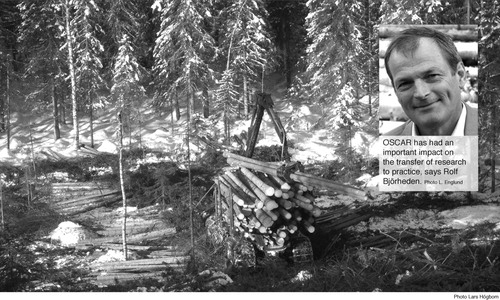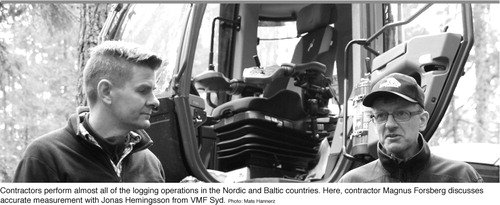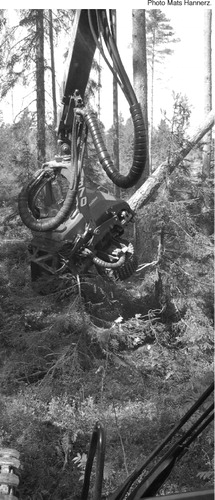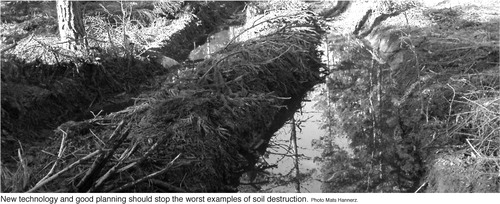OSCAR2 – a successor of a success
OSCAR2 continues the successful work of the first OSCAR project, which ran during 2005–2010. The current phase ends in 2015. The coordinator, Professor Rolf Björheden at Skogforsk, Sweden, is pleased to see that the network has led not only to progressively increased cooperation but also to implementation of results in practice.
– The work to develop heavy timber trucks, saving fuel and transport costs, started in Sweden. Finland is now introducing such trucks, with a weight of more than 70 tons, to a significant degree based on the Swedish findings. The work of OSCAR has had an important role in this implementation, he says.
Another example is the project RECO (Rational Efficient Cost Optimization), which was introduced as a training programme for Swedish machine operators. RECO has now been exported to Norway and Latvia.
– The cooperation makes it possible to share production costs for development and material, making the training even more efficient at a lower cost for each partner, Rolf Björheden continues.
A third example is the work to reduce impact on soil and water. “Water maps” that guide machines to less sensitive routes were first introduced in Sweden, but are now also being tested in Norway.
Stronger teams
Rolf Björheden sees a major benefit from the Nordic cooperation. Forest operations research has traditionally been fragmented, with only small research teams working on each issue. One or two researchers working on technical development in one country can now add partners from the other countries to form a stronger, joint theme. And joining forces is something he has seen increasing.
– In the early days of the network, it was common that researchers showed up to give their presentation, and then returned home.
– Now, discussions can address directly what we can achieve in joint action. The trust and confidence has made it possible to organize working groups in specific fields, which hold their own workshops and introduce new projects. The research becomes more efficient and advanced.
Profitability and environment
Although forest operations research is a wide field, Rolf Björheden highlights four priority areas for OSCAR2 along with its overall aims of increasing profitability, enhancing the operator environment, and reducing environmental impact:
Timber transport technology – three subgroups have been formed working on the topics 1/ High capacity transport, 2/ Central tyre inflation and 3/ Low volume roads.
Contractors – with a broad focus on the business process, communication and profitability.
Support for machine operators – such as ergonomics, computer aided decision support and automation.
Low-impact and environmentally sound harvesting – several projects are underway to reduce impact on soil and water. This involves both support for planning and driving, and technological improvements to reduce ground damage.
There is plenty of on-going activity. The second biennial conference of OSCAR2, held in Uppsala in June 2014, included over 60 presentations and abstracts, and was also attended by scientists from other parts of Europe.
– OSCAR2 has improved the already strong Nordic forest technology research cluster, and other countries want to cooperate with us.
This is recognition that the network has been successful, says Rolf Björheden.
– I feel confident that SNS is pleased with the value it has received for its seed money. The 400 000 DKK per year in support of the OSCAR network has been extremely important in bringing the network together, for knowledge sharing and, increasingly, for coordinated work on our common problems.
Read more about Oscar 1 in News&Views No. 6, 2010
The contractor is the backbone of Nordic forestry
The time when forest owners used their own employees for hands-on forest operations is ancient history. In Sweden, for example, contracted entrepreneurs perform 90% of logging operations. The situation is similar in the other Nordic and Baltic countries. Today, the logger is a contractor and the forest companies their clients.
The conditions for contractors and their role in cutting costs and improving quality in the forest sector, is under scrutiny in OSCAR. A workshop held in November 2013 in Honne, Norway, and many of the presentations at the biennial OSCAR conference in Uppsala in June 2014 also addressed the subject. Some of the presentations are shortly described here.
Technical skills are not enough
Skilled, motivated and well-informed contractors form the backbone of a professional, cost-efficient, and environmentally friendly forest sector in the Nordic countries. But being a forest entrepreneur is tough, being squeezed between clients' wishes to reduce costs and meeting environmental standards, and the contractors' own ambitions to develop their companies whilst exposed to financial and administrative pressure.
Adaptive firms are better off
So, what determines whether a contractor firm will be a success or a failure? Many Nordic researchers have looked at this question. Birger Vennesland and his colleagues in Norway interviewed CEOs of contracting firms and suggested that flexible and adaptive companies will be better off in the future. A positive attitude towards adjusting to new market trends and new technology is a winner.
Successful contractors are also one focus of attention in Sweden. The “Golden logger” award is presented to a successful logger with high profitability and employees who thrive. Niklas Fogdestam and his colleagues at Skogforsk participate in the nomination process. So far, two golden logger awards have been presented to inspire other contractors.
The situation for Finnish contractors is tough, as shown by Bo Dahlin and colleagues. The economic turmoil in the late 2000s reduced harvest volumes and made it financially tough for many firms. Many smaller firms had to wind down their business. Merging companies was one solution, but the profitability of Finnish harvesting companies has continuously declined.
The conditions for contractors in Latvia are equally challenging, as presented by Janis Gercans. LVM, the major player of Latvian forestry, is developing a price incentive system to stimulate quality, competence and method skills of contracting firms, but the Public Procurement Law puts a high weight on price, while quality is subordinate.
Planning for the future, or only for the next week?
A problem for many contractors is the often poor foresight associated with logging projects. Investment cycles for forest machinery are usually 4–6 years, while contracts with clients are much shorter. Also in the shorter perspective, clients could improve both timeliness and detail of giving harvesting instructions to contractors. Logging planning needs to be flexible since weather and other conditions can force harvesting operations to shift from one place to another. The contractor needs to be involved in this process.
The contractor needs to know if there is enough work next month, and next year, in order to invest in employees and new machinery. This was one of the topics that has been discussed by Emanuel Erlandsson and colleagues at SLU.
Malin Sääf and Klas Norin from Skogforsk have studied the current business models. They found these to be unbalanced in favour of the clients (the forest industry). The annual contracted volume is a matter of survival for the individual contractor, but usually a relatively minor issue for the client. Here, a better balance is needed, otherwise there is a risk that the best and most innovative firms will be scared away from the forest market.
Communication is a weak link
Rolf Björheden from Skogforsk presented the results of a survey covering the most urgent needs for developing Nordic-Baltic logging contractors. Communication with buyers and internal communication were highly ranked in the whole region. A study of the communication process in Swedish forestry showed that the the process varies greatly between forest districts but supported the thesis that it is a weak link in the relationship between contractor and customer.
Communication skills and dialogue has attracted the interest of many research projects. The study by Birger Vennesland and others pointed out that good communication practices, both with employees and the customer, create loyalty and trust. Malin Sääf and Klas Norin rank increased communication, respect and understanding between parties as a top priority for developing the whole supply chain.Excellence in practical operations is the focus of the RECO project, presented by Anders Mörk at Skogforsk. The RECO instructor network aims at improving fuel efficiency and productivity through practical training and follow up. It also produces extensive production of teaching material in the form of films and handbooks.
Training and improving skills of entrepreneurs is also the target of the Finnish Forest Expertise and Innovation Project, presented by Petri Murtomäki. It includes workshops and training in leadership and interpersonal skills.
Many more Nordic and Baltic studies are presented in the abstracts from Honne and Uppsala.
Proceedings of the Nordic Baltic Conference OSCAR 14. Arbetsrapport från Skogforsk nr 830–2014.
Contractor forestry. Proceedings of the 2013 OSCAR workshop held in Honne, Norway, 11–13 November 2013. Rapport fra Skog og landskap 17/2013.
Facts
Contractors – many and small, but important
Norway has about 250 contracting firms with 2–5 employees each.
Sweden has about 1500 with, on average, 4 employees.
Finland has about 2400 harvesting companies. Of these, 1300 own only one machine while around 30 companies own more than 10 harvesting machines.
Trackless logging – new technology protects water and soil
One of the OSCAR focus areas concern the problems affecting soil and water. Forestry makes huge efforts to educate machine operators and to implement new planning support. But there is more to do. At the OSCAR conference in June, 2014, a number of presentations were devoted to these issues.
New digital terrain models based on air-borne laser scanning can produce detailed maps showing information about slope, aspect and depth to groundwater. This information is used in “water maps”, showing “nogo- areas”. The maps can be used to plan extraction routes to the least sensitive areas, minimising the risk of soil and water damage. Gustav Friberg, Sima Mohtashami and their colleagues at Skogforsk showed that the ground damage decreased by almost 70% when logging operation were based on such “water maps”. It is possible to simplify planning by using an optimization process to suggest the best placing of main logging trails, with respect to costs and environmental impact.
Compaction by heavy forest machines increases soil density, and reduces its permeability to water, air and roots. A compacted soil can reduce tree growth and make damaged roots more susceptible to pathogenic fungi. Linnea Hansson at SLU presented a study of the physical changes to the soil caused by driving a fully loaded forwarder over it.
The machine itself has large effects on the risk of soil disturbance. Tyre width, tracked wheels and weight distribution are issues that have been examined by the OSCAR researchers. Ainars Lupikis and his colleagues in Latvia showed that tracked forwarders can reduce the environmental impact during thinning operations, but it is important to put harvesting residues into the tracks under the machine.
Final harvest has the potential to affect water quality in the form of run-off from the clearcut to streams. Lars Högbom from Skogforsk showed that forest buffers in the riparian zone substantially reduce the run-off of nitrate and ammonium.
Read more in Proceedings of the Nordic Baltic Conference OSCAR 14. Arbetsrapport från Skogforsk nr 830-2014.
Contact News & Views
Write to the scientific editor:
Mats Hannerz,
Silvinformation AB
More info about SNS:
News & Views is a newsletter from SNS
containing short, popularized
articles covering Nordic forest research and
forestry. Articles presenting
SNS-supported activities are prioritized. The
newsletter is published eight
times per year, and is available for
download from the SNS and Scandinavian
Journal of Forest Research websites.




